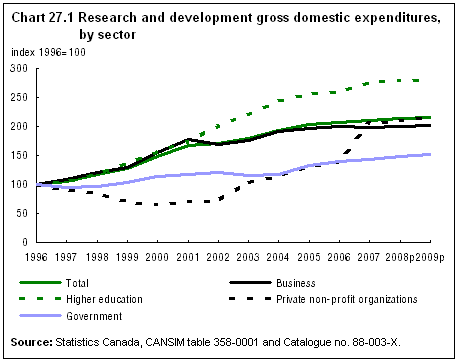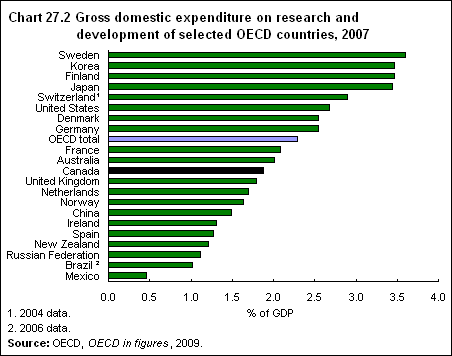Science and technology
Archived Content
Information identified as archived is provided for reference, research or recordkeeping purposes. It is not subject to the Government of Canada Web Standards and has not been altered or updated since it was archived. Please "contact us" to request a format other than those available.
Related information
Thousands of researchers are taking science and technology in new directions in laboratories and research programs across the country. Research and development (R&D) advances knowledge, leads to new technologies and creates employment opportunities.
Businesses, governments, higher-education institutions and non-profit organizations all invest significantly in R&D. The players are linked through contracts, collaborative arrangements, partnerships or donations.
The key indicator of how much money a country spends on R&D in a given year is gross domestic expenditures on research and development (GERD). Like other indicators, GERD is useful for making international comparisons of R&D activity.
In 2009, Canada's anticipated GERD totalled $29.9 billion (in current dollars). This compares with $17.6 billion in 1999.
How science is funded
Businesses expected to fund $14.2 billion in 2009, or nearly half of the total GERD, and almost the same as in each of the previous three years. The federal government is the second largest source of R&D funding ($5.7 billion in 2009), followed by the higher-education sector ($4.7 billion). The rest of GERD funding comes from provincial governments, the private non-profit sector and the foreign sector.

View data source for chart 27.1
Leading R&D performers
Businesses not only fund most R&D in the economy, they also perform most of it—$16.1 billion worth in 2009, or 54% of GERD—and employ the majority of Canada's R&D personnel. With plans to spend $10.4 billion or 35% of GERD, the higher-education sector is the second largest R&D performer. The federal government is third with R&D spending of $2.7 billion in 2009. The remainder of GERD performance takes place in the provincial government and private non-profit sectors.
Information and cultural industries (including software publishing, computer games and telecommunications) became the leading industrial group performing R&D in 2005, taking over from the communications equipment industry.
R&D expenditures by the information communications technology (ICT) sector are expected to reach $6.2 billion or 39% of total industrial R&D spending intentions in 2009. The ICT sector spans the manufacturing and services sectors and includes representation from the industry's leading R&D performers.
The manufacturing sector's share of industrial R&D declined from 68% in 2000 to 52% in 2009. In constant dollars, total industrial R&D spending had not yet recovered from the technology downturn that took place at the beginning of the millennium.
The leading federal departments or agencies performing R&D activities in 2009 included the National Research Council, Natural Resources Canada, Energy Canada, National Defence, Agriculture and Agri-Food Canada.
Canada's 2007 GERD spending comprised 1.9% of the gross domestic product (GDP), below the 2.3% average for Organisation for Economic Co-operation and Development (OECD) countries.
- Date modified:

